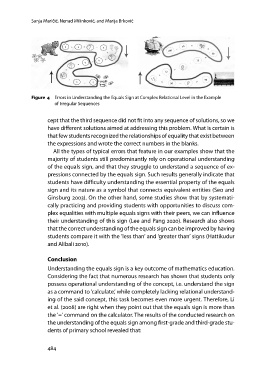Page 484 - Istenič Andreja, Gačnik Mateja, Horvat Barbara, Kukanja Gabrijelčič Mojca, Kiswarday Vanja Riccarda, Lebeničnik Maja, Mezgec Maja, Volk Marina. Ur. 2023. Vzgoja in izobraževanje med preteklostjo in prihodnostjo. Koper: Založba Univerze na Primorskem
P. 484
ja Maričić, Nenad Milinković, and Marija Brković
Figure 4 Errors in Understanding the Equals Sign at Complex Relational Level in the Example
of Irregular Sequences
cept that the third sequence did not fit into any sequence of solutions, so we
have different solutions aimed at addressing this problem. What is certain is
that few students recognized the relationships of equality that exist between
the expressions and wrote the correct numbers in the blanks.
All the types of typical errors that feature in our examples show that the
majority of students still predominantly rely on operational understanding
of the equals sign, and that they struggle to understand a sequence of ex-
pressions connected by the equals sign. Such results generally indicate that
students have difficulty understanding the essential property of the equals
sign and its nature as a symbol that connects equivalent entities (Seo and
Ginsburg 2003). On the other hand, some studies show that by systemati-
cally practicing and providing students with opportunities to discuss com-
plex equalities with multiple equals signs with their peers, we can influence
their understanding of this sign (Lee and Pang 2020). Research also shows
that the correct understanding of the equals sign can be improved by having
students compare it with the ‘less than’ and ‘greater than’ signs (Hattikudur
and Alibali 2010).
Conclusion
Understanding the equals sign is a key outcome of mathematics education.
Considering the fact that numerous research has shown that students only
possess operational understanding of the concept, i.e. understand the sign
as a command to ‘calculate,’ while completely lacking relational understand-
ing of the said concept, this task becomes even more urgent. Therefore, Li
et al. (2008) are right when they point out that the equals sign is more than
the ‘=’ command on the calculator. The results of the conducted research on
the understanding of the equals sign among first-grade and third-grade stu-
dents of primary school revealed that:
484
Figure 4 Errors in Understanding the Equals Sign at Complex Relational Level in the Example
of Irregular Sequences
cept that the third sequence did not fit into any sequence of solutions, so we
have different solutions aimed at addressing this problem. What is certain is
that few students recognized the relationships of equality that exist between
the expressions and wrote the correct numbers in the blanks.
All the types of typical errors that feature in our examples show that the
majority of students still predominantly rely on operational understanding
of the equals sign, and that they struggle to understand a sequence of ex-
pressions connected by the equals sign. Such results generally indicate that
students have difficulty understanding the essential property of the equals
sign and its nature as a symbol that connects equivalent entities (Seo and
Ginsburg 2003). On the other hand, some studies show that by systemati-
cally practicing and providing students with opportunities to discuss com-
plex equalities with multiple equals signs with their peers, we can influence
their understanding of this sign (Lee and Pang 2020). Research also shows
that the correct understanding of the equals sign can be improved by having
students compare it with the ‘less than’ and ‘greater than’ signs (Hattikudur
and Alibali 2010).
Conclusion
Understanding the equals sign is a key outcome of mathematics education.
Considering the fact that numerous research has shown that students only
possess operational understanding of the concept, i.e. understand the sign
as a command to ‘calculate,’ while completely lacking relational understand-
ing of the said concept, this task becomes even more urgent. Therefore, Li
et al. (2008) are right when they point out that the equals sign is more than
the ‘=’ command on the calculator. The results of the conducted research on
the understanding of the equals sign among first-grade and third-grade stu-
dents of primary school revealed that:
484


